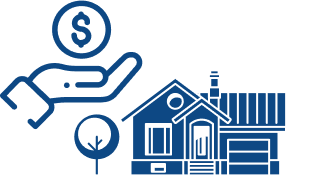When buying or selling a home, you will likely come across terms and abbreviations you don’t understand, such as DOM. So, what does DOM mean in real estate? DOM means Days on Market, indicating the number of days the house has been listed in the MLS (Multiple Listing Service). It begins when it first entered the MLS and lasts until the property is under contract.
Although this may seem simple, it can get tricky. DOM can increase even once the seller has accepted an offer and the listing status has changed. That said, your total DOM number can significantly influence your home sale. That’s why it’s critical to understand it.
One of the first questions potential buyers will ask real estate agents is how long the property has been on the market. A higher DOM than the average can negatively affect the selling price and, therefore, the seller.
In this article, we explore DOM meaning, how it impacts home sales, and how to reduce it to have better chances of selling your home at desired price and time.
What Does DOM Mean?
So, what does DOM mean in real estate? DOM stands for Days on Market. It’s an industry term used for helping potential buyers and real estate agents understand how long a house has been listed on MLS for sale. Day 1 is the day a property is under contract with a real estate agent and listed on the MLS, whereas the last day is when a home goes under contract with a prospective buyer.
Home Selling Stages
There are several stages involved in the home selling process, and they appear in the MLS under different market statuses. That said, the MLS status will likely move to one of the following stages once the seller accepts an offer.
- Under contract: In this stage, the seller has accepted an offer, and the buyer is clearing his financing and inspection contingencies. During the under-contract stage, the seller is still willing to consider another offer if the first one falls through. In this case, the DOM clock is still running.
- Contingent: In this stage, the seller has accepted an offer contingent upon something else happening, often meaning the buyer has a house they need to sell in order to buy the seller’s home. Their house may still be under contract and waiting to close or not on the market yet at all. In this case, many sellers continue to market the home, hoping they will get a better offer. And if the seller receives another offer, the first buyer typically has the chance to remove the contingency. However, if they can’t remove their contingency, the seller might accept the other offer. Here, the DOM clock also continues to run.
- Pending: Here, the transaction is past due diligence requirements and ready to close. The DOM clock stops in this stage.
Note that if the contract falls out because of issues with inspection or financing, the house returns to the market. In this case, the DOM clock continues to run. If the status was pending, the clock continues to run from where it stopped.
Why Is DOM Important?
DOM can be used as an indicator of the real estate market but also of how well a house is priced. A higher DOM can be a bad sign and negatively affect the final selling price. That said, the ratio between DOM and sales price is typically inverse, meaning that the longer the property sits on the market, the lower the selling prices will likely be. Here's how long it takes to sell a house in the US.
On the other hand, when a property is on the market for a short period, the list and sale prices tend to be similar. Considering the tax implications of selling, it’s always better to sell your home at a higher price. And with shorter DOMs, many houses sell for more than their listing prices.
Note that buyers often use days on market to decide their offer, and if the property has been on the market for a long time, they may be considering a lower offer.
In addition, the higher the DOM, the more questions the potential buyer asks, such as: “Why hasn’t the home sold? What’s wrong with the property? How low will the seller go?”. As you can imagine, questions like these can further affect the home selling price to the seller's detriment.
Consider the History of a Property
When looking at a property with higher DOM, buyers should consider its history because the house may have been reduced in price, removing the major factor that was preventing buyers from purchasing it.
The number of days on the market can be misleading also if the status of the house changed to contingent a few days after being listed, but the sale fell apart. This can give you an impression that the property has been on the market for much longer than it has been in reality.
Can DOM Be Reset?
If the listing expires or is canceled, the days on market will go back to zero once relisted by another real estate agent. In some parts of the country, DOM standards show the previous listing history, also known as CDOM (cumulative days on market). Otherwise, the DOM can’t be changed and will continue growing.
Some real estate agents relist the house while it’s still for sale after a significant price reduction, so the property appears in the listing updates as a new home for sale. However, any seasoned buyer’s agent and a knowledgeable home buyer will see through this strategy
What’s the Difference Between DOM vs. CDOM?
CDOM stands for cumulative days on market and indicates the total sum of days the property has been available for sale without a successful closing. It differs from DOM as it describes all DOMs for the same listing.
Let’s say a home has been listed for 16 days. On day 16, a prospective buyer goes under contract with the seller to buy the property. However, the deal falls through after a week. In this case, the property is relisted on the MLS with a DOM of 1 and CDOM of 17 - the original 16 days and the new day one listing.
Still, CDOM doesn’t indicate the total sum of days a property has ever been listed. Instead, it relates to the most current try to sell the house.
How to Reduce the DOM
As we mentioned, the longer the property is in MLS, the smaller the chance it will sell at the desired price. For this reason, sellers should focus on reducing the home’s time on the market.
There may be some things that are deterring buyers from making an offer. If you understand where the issues are and fix them, you can keep the DOM low. Here’s advice on how to reduce the number of the days on market and sell your house faster and at a favorable price.
Set the Correct Price
The DOM statistic is an excellent indicator of how well a property is priced. Houses that are competitively priced tend to go under contract faster than their overpriced competition.
More often than not, sellers choose a price that’s above where the property should be listed in reality because they can always drop the price if they don’t get any offers. However, the best showings happen in the first several days on the market.
The first prospective buyer will already have been looking for a while and even lost out on a couple of houses and will jump on a well-priced property. But if the house is overpriced, they will likely overlook it. They assume the seller won’t take a lower offer since the listing is new. However, as the DOM clock accumulates time, homebuyers begin to wonder where the problem lies.
Eventually, the seller will consider dropping the prices. But as the price reduces, the DOM grows, creating even more suspicion about the property. When this happens, sellers tend to chase the market with the following price reductions, yielding lower offers and selling for less than they planned.
That’s why pricing the house correctly from the start can generate a higher net and prevent a significant price reduction. Typically, sellers see the highest net profit during the first 30 days on the market, and this is why strategic and realistic pricing is essential.
Correct pricing from the start is an excellent way to generate buyers and offers. The idea here is to price the home properly so you can get multiple offers. This is the best way for a seller to get more than the asking price. That said, once the potential buyers see the property as a great value, they are willing to make an offer, and the more offers you generate, the higher the final selling prices will be.
Be Flexible
To sell a house, you need to show it to prospective buyers. However, this may not always be convenient. If they can't see the property, they likely won’t make an offer. That’s why sellers need to be willing to change their plans to allow potential buyers to view the house.
Stage the House
If you want to sell your home quickly, it needs to look great. This can mean decluttering, cleaning, making minor repairs, and painting. This is a vital step in the home selling process because properties that look uncared for tend to stay on the market for a longer time.
So, make sure your home is neat and clean, fix the taps, paint the walls in neutral colors (buyers like neutral colors because, this way, they can imagine how their space would look), and remove your photos and other things that infuse the property with your life. Also, enhance the curb appeal by planting some flowers. This way, your home will look inviting and have better chances of selling quickly at the desired price.
If your home is under HOA, make sure to follow their guidelines when enhancing your home and increasing its value.
Get the Marketing Right
Once you stage your home, it’s time to focus on marketing. One study found properties with high-quality photographs sell 32% faster than homes without them. So, it's a good idea to get professional photographers to make an excellent first impression when the buyer sees your home in the MLS listings. This can be a deciding factor in their decision-making process. Having a detailed description in the listing can help too.
The marketing can include social media posts, classified advertising, but also old-school tactics such as signs, postcards, and print ads.
Negotiate
When selling a home, you may get offers you consider too low. In this case, it’s important to negotiate to not sell your property for less than its worth. However, negotiating isn’t easy if you have a lot of emotions tied up in the house. That said, keep your emotions in check and try to find the middle solution.
Choose a Skilled Real Estate Agent
A skilled real estate agent can help accelerate the home selling process because they know the market. They will likely find a buyer quickly and ensure the best possible price.
It may be tempting to hire the first agent you find, but it’s better to be more selective. So, don’t hesitate to contact several agents and choose the one that seems to be the most qualified. Looking for their track records of success can help too.
Skip the Hassle: Sell Your Home Quickly
In this article, we have answered the question: “What does DOM mean in real estate?”, and discussed how DOM can impact the final selling price. You also got several tips on how to reduce this number and sell your home faster at the desired price. Even so, the home selling process can be tricky and full of surprises.
If you want to skip all the hassle and sell your home quickly and for top dollar without making any repairments, marketing, and real estate agents, contact SleeveUp Homes. We’ll buy your home as is for the best price. And you don’t have to take our word for it - request a no-obligation cash offer and see for yourself!
SELL
YOUR HOUSE
If you want to sell fast and are worried about how long the traditional process takes, and the commission and fees involved, consider working with SleeveUp Homes.





 view all blogs by this author
view all blogs by this author Cesar Gomez (85 blogs)
Cesar Gomez (85 blogs)